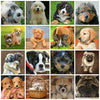When determining the best dog collars to use in Australia, pet owners often ask around for other owners' experiences. Otherwise, the Internet would be packed with searches like "which dog collars have the best product life", "recommended dog collars for a large dog", "which dog collars have the best harness", and so on.
But with so many kinds of dog collars on the market, which one is the most suitable for your dog? The choice of a dog collar depends on the dog's size, behaviour, personality and whether it is used for training. For most dogs, a regular leather or nylon collar will suffice.
Read on to find useful information in helping you find the most suitable collar for your dog.
General collar. The material of this kind of dog collar varies from leather, nylon cloth, plastic, cotton, synthetic leather, and more. It is not appropriate to wear it too tight or too loose. There should be a space between the neck and the collar for two fingers to pass through. In addition, the collars are divided into wide and thin versions, with large dogs opting for the wide version and small dogs opting for the thin one.
➤ The potential risk of general collars: Dogs have many vital organs on their neck, so an unsuitable collar or a sudden pull that puts too much pressure on their trachea or throat can cause injury.
Chest strap/dog harness. The material of this kind of dog collar varies from leather, nylon cloth, Oxford cloth, etc. There are many styles and types to choose from like chest button, back button and vest. It has been recommended by veterinarians for use on the type of dogs with delicate trachea. When you pull the rope with an appropriate amount of force, the force can be evenly distributed which cushions the pull.
➤ Potential risks of chest strap/dog harness: Poorly designed or ill-fitting straps, in addition to being easy for them to break free, can lead to injuries from friction, even contusion from compression, and, in the case of long-haired dogs, the formation of fur knots.
P Chain. The material of this kind of dog collar varies from leather, nylon cloth, metal and even braided ropes. When worn, the chain must be in a P shape. The additional function is to use instantaneous pressure to control the dog's behaviour, but it is recommended that you have mastered the used of the P chain before actually using it on your dog.
➤ Potential risks of P chains: You have to be careful when using them. Careless use can cause damage to your dog's trachea, throat, etc.
Head Collar (HC). The material of head collars is mostly nylon cloth. It is a kind of restraint and behaviour training aid designed according to animal behaviour, similar to the reins on a horse. It consists of two nylon straps, one around the bridge of the dog's nose and the other around the back of the dog's neck. When you pull the leash with the right amount of force, it puts pressure on the bridge of the nose and neck and stabilizes your dog. It is often used to correct barking, aggression, and irritability.
Some people may worry about the wellbeing of the dog when seeing this style of collar being used, or even have an assumption that the dog will bite. Dog owners who worry about public perception may have no choice but to give up using this style of collar.
➤ The potential risk of head collar: Improper use will cause psychological trauma for the dog.
Conclusion
To sum things up, no matter what style of dog collar, there must be a design philosophy behind it. There isn't a 'one size fits all' solution. The major questions to ask when choosing a great collar for your dog can be summarised as below:
Does the style of dog collar/dog harness provide adequate protection for the dog and those around them?
Is the style of dog collar/dog harness comfortable for your dog to wear?
Is the size correct for your dog? I.e. not too tight for large dogs, and not too loose for small dogs?
Does the style of dog collar/dog harness provide adequate means to avoid sudden and violent jerks on the dog that might injure them?
Are you as the trainer adequately trained to use the style of dog collar/dog harness that you have chosen?









